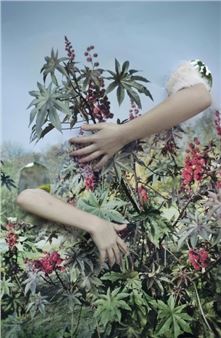Simona Runcan: Silent Cohabitations
Simona Runcan's paintings still seem to come into being, even though they were started more than 30 years ago. They are still taking shape: the cones, the cylinders, and the other fgures that keep on reappearing in her paintings, all seem to be changing as one is looking at them. Ever so slightly leaning or ever so slowly falling apart. Runcan would make these fgures using various pieces of fabric – twisting them, turning them, and tying them up. Or by simply letting the fabric wrap around an object that she had made - hiding it and letting the outlines of it get blurred. She would arrange these fgures on a horizontal line and photograph them prior to painting them. The painting ending up ofering a matter-of-fact observation of what are not facts, but something that is concealed rather than revealed. The painting becoming as much about what can not be seen or the tension of the fabric that could come undone. The painting still holding onto the energy of instability that these fgures initially were in possession of. They are neither frmly fxed to the ground nor entirely fnding its place within the pictorial space. Their folds, their fne lines, and their shifting hues that provide them with plasticity, are set against a solid background that so willingly is collapsing any notion of depth or nuance. Then, as she was approaching the year of 1989 and became a witness to the Romanian revolution, these shapes would be returning but also shifting. Through the fabric one senses not so much the outline of a body, as one senses the movements of a body in pain. The way that the fabric now is twisted, turned and tied up, making for a diferent sort of distortion. Wreaths that are commemorating the dead are resting on the ground, while around them everything is coming to life.

Recommended for you
Simona Runcan's paintings still seem to come into being, even though they were started more than 30 years ago. They are still taking shape: the cones, the cylinders, and the other fgures that keep on reappearing in her paintings, all seem to be changing as one is looking at them. Ever so slightly leaning or ever so slowly falling apart. Runcan would make these fgures using various pieces of fabric – twisting them, turning them, and tying them up. Or by simply letting the fabric wrap around an object that she had made - hiding it and letting the outlines of it get blurred. She would arrange these fgures on a horizontal line and photograph them prior to painting them. The painting ending up ofering a matter-of-fact observation of what are not facts, but something that is concealed rather than revealed. The painting becoming as much about what can not be seen or the tension of the fabric that could come undone. The painting still holding onto the energy of instability that these fgures initially were in possession of. They are neither frmly fxed to the ground nor entirely fnding its place within the pictorial space. Their folds, their fne lines, and their shifting hues that provide them with plasticity, are set against a solid background that so willingly is collapsing any notion of depth or nuance. Then, as she was approaching the year of 1989 and became a witness to the Romanian revolution, these shapes would be returning but also shifting. Through the fabric one senses not so much the outline of a body, as one senses the movements of a body in pain. The way that the fabric now is twisted, turned and tied up, making for a diferent sort of distortion. Wreaths that are commemorating the dead are resting on the ground, while around them everything is coming to life.
Artists on show
Related articles
Artist: Simona Runcan Exhibition title: Silent Cohabitations Venue:МэSTANDARD (OSLO), Oslo, Norway Date: November 18 – December 18, 2021.












